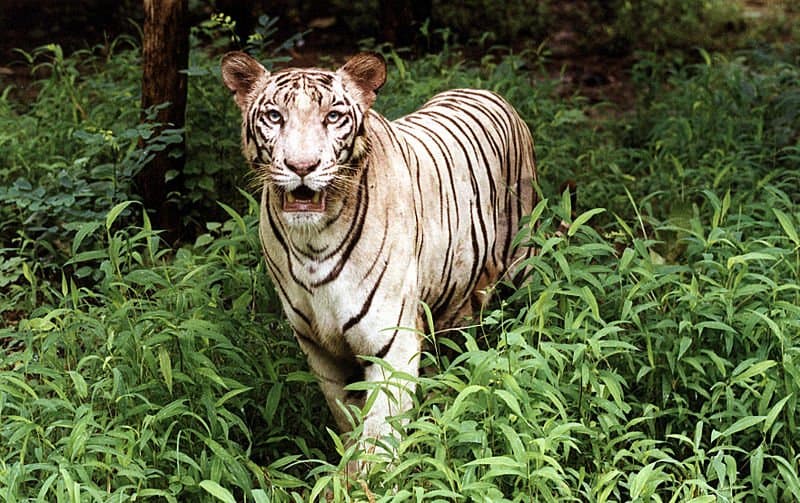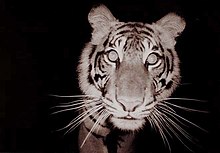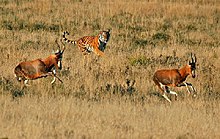The
tiger (
Panthera tigris) is the largest
cat species,
most recognizable for its pattern of dark vertical stripes on
reddish-orange fur with a lighter underside. The species is classified
in the genus
Panthera with the
lion,
leopard,
jaguar, and
snow leopard. It is an
apex predator, primarily preying on
ungulates such as
deer and
bovids. It is territorial and generally a
solitary but social predator, often requiring large contiguous areas of
habitat
that support its prey requirements. This, coupled with the fact that it
is indigenous to some of the more densely populated places on Earth,
has caused significant
conflicts with humans.
Tiger populations once ranged widely across
Eurasia, from the
Black Sea in the west, to the
Indian Ocean in the south, and from
Kolyma to
Sumatra in the
east. Over the past 100 years, they have lost 93% of their historic range, and have been extirpated from
Western and
Central Asia, from the islands of
Java and
Bali, and from large areas of
Southeast,
South, and
East Asia. Today, they range from the Siberian
taiga to open
grasslands and tropical
mangrove swamps. The species has been classified as
endangered in the
IUCN Red List. Major reasons for population decline include
habitat destruction,
habitat fragmentation and
poaching. The extent of area inhabited by tigers is estimated at less than 1,184,911 km
2
(457,497 sq mi), a 41% decline from the area estimated in the
mid-1990s. The global wild population is estimated to number between
3,062 and 3,948 individuals, down from around 100,000 at the start of
the 20th century, with most remaining populations occurring in small
pockets isolated from each other, in which about 2,000 tigers live on
the
Indian subcontinent.
[1] In 2016, an estimate of a global
wild
tiger population of approximately 3,890 individuals was presented
during the Third Asia Ministerial Conference on Tiger Conservation.
[4][5] The
WWF declared that the world's count of wild tigers has risen for the first time in a century.
[6]
The tiger is among the most recognisable and popular of the world's
charismatic megafauna. It featured prominently in ancient
mythology and
folklore, and continues to be depicted in modern films and literature, appearing on many
flags,
coats of arms, and as
mascots for sporting teams. The tiger is the
national animal of
Bangladesh,
India,
Malaysia and
South Korea.

Etymology

The word
Panthera is probably of
Oriental origin and retraceable to the
Ancient Greek word
panther, the
Latin word
panthera, the
Old French word
pantère, most likely meaning "the yellowish animal", or from
pandarah meaning
whitish-yellow. The derivation from
Greek pan- ("all") and
ther ("beast") may be
folk etymology.
[7]
The word
specific name tigris derives from the
Classical Greek language τίγρις meaning "tiger" as well as the river
Tigris.
[8]
The
Middle English tigre and the
Old English tigras (a plural word) were both used for the animal.
[9] These derive from the Old French
tigre, itself a derivative of the
Latin word
tigris. The original source may have been the
Persian tigra meaning pointed or sharp and the
Avestan tigrhi meaning an arrow, perhaps referring to the speed with which a tiger launches itself at its prey.
[10]
Taxonomy

In 1758,
Carl Linnaeus described the tiger in his work
Systema Naturae and gave it the
scientific name Felis tigris.
[3] In 1929, the British taxonomist
Reginald Innes Pocock subordinated the species under the genus
Panthera using the scientific name
Panthera tigris.
[11][12]
Recent subspecies
Following Linnaeus's first descriptions of the species, several tiger
specimens were described and proposed as
subspecies.
[13] The
validity
of several tiger subspecies was questioned in 1999. Most putative
subspecies described in the 19th and 20th centuries were distinguished
on basis of fur length and coloration, striping patterns and body size,
hence characteristics that vary widely within populations.
Morphologically, tigers from different regions vary little, and
gene flow between populations in those regions is considered to have been possible during the
Pleistocene. Therefore, it was proposed to recognize only two tiger subspecies as valid, namely
P. t. tigris in mainland Asia, and
P. t. sondaica in the
Greater Sunda Islands and possibly in
Sundaland.
[14]
Results of
craniological
analysis of 111 tiger skulls from Southeast Asian range countries
indicate that Sumatran tiger skulls differ from Indochinese and Javan
tiger skulls, whereas Bali tiger skulls are similar in size to Javan
tiger skulls. The authors proposed to classify Sumatran and Javan tiger
as distinct species,
P. sumatrae and
P. sondaica with Bali tiger as subspecies
P. sondaica balica.
[15]
In 2015, morphological, ecological and molecular traits of all
putative tiger subspecies were analysed in a combined approach. Results
support distinction of the two evolutionary groups continental and Sunda
tigers. The authors proposed recognition of only two subspecies, namely
P. t. tigris comprising the Bengal, Malayan, Indochinese, South Chinese, Siberian and Caspian tiger populations, and
P. t. sondaica
comprising the Javan, Bali and Sumatran tiger populations. The authors
also noted that this reclassification will affect tiger conservation
management.
[16]
One conservation specialist welcomed this proposal as it would make
captive breeding programmes and future rewilding of zoo-born tigers
easier. One
geneticist was sceptical of this study and maintained that the currently recognised nine subspecies can be distinguished genetically.
[17]
In 2017, the Cat Classification Task Force of the
IUCN Cat Specialist Group revised felid taxonomy and now recognizes the tiger populations in continental Asia as
P. t. tigris, and those in the Sunda Islands as
P. t. sondaica.
[18]
The following table is based on the
classification of the species
Panthera tigris provided in
Mammal Species of the World.
[13] It also reflects the classification used by the Cat Classification Task Force:
Non-insular Asia
| Subspecies |
Description |
Image |
| Bengal tiger (P. t. tigris) (Linnaeus, 1758)[18][13] |
The Bengal tiger's coat colour varies from light yellow to reddish yellow with black stripes.[19]
Males attain a total nose-to-tail length of 270 to 310 cm (110 to
120 in) and weigh between 180 to 258 kg (397 to 569 lb), while females
range from 240 to 265 cm (94 to 104 in) and 100 to 160 kg (220 to
350 lb).[20][21]
In northern India and Nepal, the average is larger; males weigh up to
235 kilograms (518 lb), while females average 140 kilograms (310 lb).[22] Recorded body weights of wild individuals indicate that it is the heaviest subspecies.[23]
This population occurs in Bangladesh, Bhutan, India, Nepal, foremost in alluvial grasslands, subtropical and tropical rainforests, scrub forests, wet and dry deciduous forests and mangrove habitats. It is extinct in Pakistan.[1] In 2014, the population in India was estimated at 2,226 mature individuals,[24] 163–253 in Nepal and 103 in Bhutan.[25] |
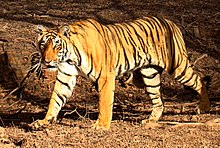 |
| Caspian tiger (P. t. tigris),[18] formerly P. t. virgata (Illiger, 1815)[13] |
The Caspian tiger was described as having narrow and closely set stripes.[26] The size of its skull did not differ significantly from that of the Bengal tiger.[14] According to genetic analysis, it was closely related to the Siberian tiger.[27]
The population inhabited forests and riverine corridors from Eastern Anatolia, South Caucasus and coast of Caspian Sea, along the coast of the Aral Sea, in Amu-Darya and Syr-Darya basins to the southern shore of Lake Balkhash and into the Altai Mountains.[26] It had been recorded in the wild until the early 1970s and is considered extinct since the late 20th century.[28] |
 |
| Siberian tiger (P. t. tigris),[18] formerly P. t. altaica (Temminck, 1844).[13] Also known as the Amur tiger. |
The Siberian tiger has a thick coat with pale hues and few dark brown stripes.[26]
Males have a head and body length of between 190 and 230 cm (75 and
91 in) and weigh between 180 and 306 kg (397 and 675 lb), while females
average 160 to 180 cm (63 to 71 in) and 100 to 167 kg (220 to 368 lb).
Tail length is about 60–110 cm (24–43 in).[20]
This population inhabits the Amur-Ussuri region of Primorsky Krai and Khabarovsk Krai in far eastern Siberia, with a small population in Hunchun National Siberian Tiger Nature Reserve in northeastern China near the border to North Korea.[29][30] It is extinct in Mongolia, North Korea, and South Korea.[1]
In 2005, there were 331–393 adult and subadult Siberian tigers in the
region, with a breeding adult population of about 250 individuals.[31] As of 2015, there was an estimated population of 480-540 individuals in the Russian Far East.[32] |
 |
| Indochinese tiger (P. t. tigris),[18] formerly P. t. corbetti Mazák, 1968[13] |
The Indochinese tiger was described as being smaller than the Bengal
tiger and as having a smaller skull. Males average 108 inches (270 cm)
in total length and weigh between 150 and 195 kg (331 and 430 lb), while
females average 96 inches (240 cm) and 100–130 kg (220–290 lb).[20]
This population occurs in Myanmar, Thailand, Laos, but has not been recorded in Vietnam since 1997. In 2010, the population in Indochina
was estimated at about 350 individuals. In Southeast Asia, tiger
populations have declined in key areas and are threatened by illegal
production of tiger bone for use in traditional medicine.[1] |
 |
| Malayan tiger (P. t. tigris),[18] formerly P. t. jacksoni Luo et al., 2004 |
There is no clear difference between the Malayan and the Indochinese tiger in pelage or skull size.[33] It was proposed as a distinct subspecies on the basis of mtDNA and micro-satellite sequences that differs from the Indochinese tiger.[34]
Males range in total length from 190–280 cm (75–110 in) and weigh
between 47.2 to 129.1 kg (104 to 285 lb), while females range from
180–260 cm (71–102 in) and 24 to 88 kg (53 to 194 lb).[35]
The population was roughly estimated at 250 to 340 adult individuals
in 2013, and likely comprised less than 200 mature breeding individuals
at the time.[36]
The geographic division between Malayan and Indochinese tigers is
unclear as tiger populations in northern Malaysia are contiguous with
those in southern Thailand.[1] In Singapore the last tiger was shot in 1932; tigers are considered extirpated since the 1950s.[35] |
 |
| South China tiger (P. t. tigris),[18] formerly P. t. amoyensis (Hilzheimer, 1905)[13] |
The South China tiger is considered to be the most ancient of the
tiger subspecies and is distinguished by a particularly narrow skull,
long-muzzled nose, rhombus-like
stripes and vivid orange colour. Males range in total length from
230–260 cm (91–102 in) and weigh between 130 to 180 kg (290 to 400 lb),
while females range from 220–240 cm (87–94 in) and 100 to 110 kg (220 to
240 lb).[20]
The population is extinct in the wild.[1] Despite unconfirmed reports and some evidence of footprints, there has been no confirmed sighting in China since the early 1970s.[37] As of 2007, the captive population consisted of 73 individuals, which derived from six wild founders.[38] |
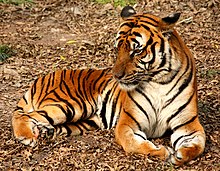 |
Sunda Islands
| Subspecies |
Description |
Image |
| Javan tiger (P. t. sondaica) (Temminck, 1844)[18][13] |
The Javan tiger was small compared to tigers of the Asian mainland.[20] Males weighed 100–141 kg (220–311 lb) and females 75–115 kg (165–254 lb).[33]
This population was limited to the Indonesian island of Java, and had been recorded until the mid-1970s.[39] After 1979, no more sightings were confirmed in the region of Mount Betiri.[40] An expedition to Mount Halimun Salak National Park in 1990 did not yield any definite, direct evidence for the continued existence of tigers.[41] |
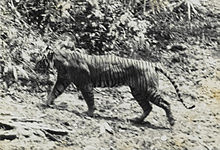 |
| Bali tiger (P. t. sondaica),[18] formerly P. t. balica (Schwarz, 1912)[13] |
The Bali tiger was the smallest tiger and limited to the Indonesian island of Bali. It had a weight of 90–100 kg (200–220 lb) in males and 65–80 kg (143–176 lb) in females.[42] A typical feature of Bali tiger skulls is the narrow occipital plane, which is analogous with the shape of skulls of Javan tigers.[43]
In Bali, tigers were hunted to extinction; the last Bali tiger, an
adult female, is thought to have been killed at Sumbar Kima, West Bali,
on 27 September 1937, though there were unconfirmed reports that
villagers found a tiger corpse in 1963.[44] |
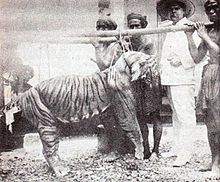 |
| Sumatran tiger (P. t. sondaica),[18] formerly P. t. sumatrae Pocock, 1929[13] |
It is the smallest of all living tigers. Males range in total length
from 220 to 255 cm (87 to 100 in) and weigh between 100 to 140 kg (220
to 310 lb), while females range between 215 to 230 cm (85 to 91 in) and
75 to 110 kg (165 to 243 lb).[20] The reasons for its small size compared to mainland tigers are unclear, but probably the result of competition for limited and small prey.[14]
The population is thought to be of Asia mainland origin and to have
been isolated about 6,000 to 12,000 years ago after a rise in sea-level
created the Indonesian island of Sumatra.[33][45]
The population is the last surviving of the three Indonesian island tiger populations. It is listed as Critically Endangered on the IUCN Red List. By 2008, the wild population was estimated at between 441 and 679 in 10 protected areas covering about 52,000 km2 (20,000 sq mi).[46] |
 |
Evolution and genetics
Tiger phylogenetic relationships
Restoration of Panthera zdanskyi, an extinct relative whose oldest remains were found in northwest China, suggesting the origins of the tiger lineage
The tiger's closest living relatives were previously thought to be the
Panthera species lion, leopard and jaguar. Results of
genetic analysis indicate that about 2.88 million years ago, the tiger and the
snow leopard diverged from the other
Panthera species, and that both may be more closely related to each other than to the lion, leopard and jaguar.
[47][48] Results of a
phylogeographic study indicate that all living tigers had a common ancestor 72,000–108,000 years ago.
[34]
Fossil remains of the
Longdan tiger were found in the
Gansu province of northwestern China. This species lived at the beginning of the
Pleistocene, about 2 million years ago, and is considered to be a
sister taxon
of the modern tiger. It was about the size of a jaguar and probably had
a different coat pattern. Despite being considered more "
primitive",
the Longdan tiger was functionally and possibly ecologically similar to
the modern tiger. As it lived in northwestern China, that may have been
where the tiger lineage originated. Tigers grew in size, possibly in
response to
adaptive radiations of prey species like
deer and
bovids, which may have occurred in Southeast Asia during the early Pleistocene.
[49]
The earliest fossils of true tigers are between 1.6 and 1.8 million
years old and were found in Java. Distinct fossils are known from the
early and middle Pleistocene deposits in China and Sumatra. The
Trinil tiger (
Panthera tigris trinilensis) lived about 1.2 million years ago and is known from fossils found at
Trinil in
Java.
[citation needed] The
Wanhsien,
Ngandong, Trinil and Japanese tigers became extinct in
prehistoric times.
[50]
Tigers first reached India and northern Asia in the late Pleistocene, reaching eastern
Beringia,
Japan, and
Sakhalin. Some fossil skulls are morphologically distinct from lion skulls, which could indicate tiger presence in Alaska during the
last glacial period, about 100,000 years ago.
[51] Fossils found in Japan indicate the local tigers were smaller than the mainland forms, possibly due to
insular dwarfism. Until the
Holocene, tigers also lived in
Borneo and on the
Palawan island in the
Philippines.
[52]
The tiger's
full genome sequence was published in 2013. It was found to have similar repeat composition than other cat genomes and an appreciably conserved
synteny.
[53]

Hybrids
Lions have been known to
breed with tigers (most often the
Amur and Bengal tigers) to create
hybrids called
ligers and
tigons.
Such hybrids were once commonly bred in zoos, but this is now
discouraged due to the emphasis on conservation. Hybrids are still bred
in private menageries and in zoos in
China.
[citation needed]
The liger is a cross between a male lion and a tigress.
[54] Because the lion sire passes on a growth-promoting gene, but the corresponding growth-inhibiting gene from the
female
tiger is absent, ligers grow far larger than either parent species.
They share physical and behavioural qualities of both parent species
(spots and stripes on a sandy background).
Male
ligers are sterile, but female ligers are often fertile. Males have
about a 50% chance of having a mane, but, even if they do, their manes
will be only around half the size of that of a pure lion. Ligers are
typically between 10 and 12 ft (3.0 and 3.7 m) in length, and can weigh
between 800 and 1,000 lb (360 and 450 kg) or more.
[54]
The less common tigon is a cross between a lioness and a male tiger.
[55]
Because the male tiger does not pass on a growth-promoting gene and the
lioness passes on a growth inhibiting gene, tigons are often relatively
small, only weighing up to 150 kg (330 lb). Like ligers, they have
physical and behavioural traits from both parental species, and males
are sterile. Females are sometimes fertile and have occasionally given
birth to
litigons when mated to a male
Asiatic lion.
[56]


Characteristics
Though the tiger's
skull is similar to that of the lion, the lower jaw structure is a reliable indicator of the species
The tiger has a muscular body with powerful forelimbs, a large head and a tail that is about half the length of its body. Its
pelage is dense and heavy, and
colouration varies between shades of orange and brown with white
ventral areas and distinctive vertical black stripes that are unique in each individual.
[57][20] Stripes are likely advantageous for
camouflage in vegetation such as long grass with strong vertical patterns of light and shade.
[58][59] The tiger is one of only a few striped cat species; it is not known why spotted patterns and
rosettes are the more common camouflage pattern among felids.
[60] A tiger's coat pattern is still visible when it is
shaved. This is due not to skin pigmentation, but to the
stubble and
hair follicles embedded in the skin, similar to human beards (colloquially
five o'clock shadow), and is in common with other big cats.
[61] They have a mane-like heavy growth of fur around the neck and jaws and long whiskers, especially in males. The
pupils are circular with yellow
irises. The small, rounded ears have a prominent white spot on the back, surrounded by black.
[20] These false "eyespots", called
ocelli, apparently play an important role in intraspecies communication.
[62]
The skull is
similar to that of the lion,
though the frontal region is usually not as depressed or flattened,
with a slightly longer postorbital region. The skull of a lion has
broader nasal openings. However, due to variation in skulls of the two
species, the structure of the lower jaw is a more reliable indicator of
the species.
[26] The tiger also has fairly stout teeth; the somewhat curved
canines are the longest among living felids with a
crown height of up to 90 mm (3.5 in).
[20]
Size
Tigers are the most variable in size of all big cat species.
[19] There is a notable
sexual dimorphism
between males and females, latter being consistently smaller than
males. The size difference between males and females is proportionally
greater in the large tiger subspecies, with males weighing up to 1.7
times more than females. Males also have wider forepaw pads than
females, enabling gender to be told from tracks.
[63]
Males vary in total length from 250 to 390 cm (98 to 154 in) and weigh
between 90 to 306 kg (198 to 675 lb) with skull length ranging from 316
to 383 mm (12.4 to 15.1 in). Females vary in total length from 200 to
275 cm (79 to 108 in), weigh 65 to 167 kg (143 to 368 lb) with skull
length ranging from 268 to 318 mm (10.6 to 12.5 in).
[64] The heaviest wild tiger ever reported had a total body length of 3.38 m (11.1 ft) over curves.
[65] In either sex, the tail represents about 0.6 to 1.1 m (24 to 43 in) of total length.
[20]
Large male Siberian tigers reach a total length of more than 3.5 m
(11.5 ft) over curves and 3.3 m (10.8 ft) between pegs, with a weight of
up to 306 kg (675 lb). This is considerably larger than the weight of
75 to 140 kg (165 to 309 lb) reached by the
Sumatran tiger. At the shoulder, tigers may variously stand 0.7 to 1.22 m (2.3 to 4.0 ft) tall.
[42]
The heaviest tiger on record was a Bengal tiger shot in 1967 allegedly
weighing 388.7 kg (857 lb); unverified is whether this individual had a
full or empty stomach.
[66] It has been
hypothesised that body size of different tiger populations may be correlated with climate and be explained by
thermoregulation and
Bergmann's rule, or by distribution and size of available prey species.
[20][67]
The Bengal and Siberian tigers are amongst the tallest cats in shoulder height.
[68][65] They are also ranked with the Caspian tiger among the biggest cats that ever existed.
[20]
However, a wild adult male Siberian tiger at 176.4 kilograms (389 lb)
body weight is outweighed by an adult, male Bengal tiger at 196
kilograms (432 lb).
[23][69]
To
compare, the weight of a male
Southern African lion has been indicated as 187.5 to 193.3 kg (413 to 426 lb).
[70]
Colour variations
White tigers, this
recessive colour variant is found in the Bengal and Siberian tigers, and with regular stripes and blue eyes. It is not
albinism.
A
golden tiger, another colour variant, results in thicker light-gold fur, pale legs and faint orange stripes
A well-known
allele found only in the Bengal population produces the
white tiger,
a colour variant first recorded in the early 19th century and found in
an estimated one in 10,000 natural births. Genetically, whiteness is
recessive: a cub is white only when both parents carry the allele for whiteness.
[71] It is not
albinism, pigment being evident in the white tiger's stripes and in their blue eyes.
[58] The causative mutation changes a single
amino acid in the transporter protein
SLC45A2.
[72]
White tigers are more frequently bred in captivity, where the comparatively small gene pool can lead to
inbreeding. This has given white tigers a greater likelihood of being born with physical defects, such as
cleft palate,
scoliosis (curvature of the spine), and
strabismus (squint).
[71]
Even apparently healthy white tigers generally do not live as long as
their orange counterparts. Attempts have been made to cross white and
orange tigers to remedy this, often mixing with other subspecies in the
process.
[73]
Another recessive gene creates the "golden" or "golden tabby" colour variation, sometimes known as "strawberry".
Golden tigers
have thicker than usual light-gold fur, pale legs, and faint orange
stripes. Few golden tigers are kept in captivity; they are invariably at
least part Bengal. Some golden tigers carry the white tiger gene,
[74] and when two such tigers are mated, they can produce some stripeless white offspring. Although a "pseudo-
melanistic" effect—wide stripes that partially obscure the orange background—has been seen in some pelts, no true
black tigers have been authenticated, with the possible exception of one dead specimen examined in
Chittagong
in 1846. These wholly or partially melanistic tigers, if they exist,
are assumed to be intermittent mutations rather than a distinct species.
[75][76] There are further unconfirmed reports of a "blue" or slate-coloured variant, the
Maltese tiger.
However, while some felids do exhibit this colouration as a solid coat,
there is no known genetic configuration that would result in black
stripes on a blue-gray background.
[75]

Distribution and habitat
At the end of the
last glacial period about 20,000 years ago, the tiger was widespread from
Eastern Anatolia Region and
Mesopotamia, in
Central Asia to eastern
Siberia and
South and
Southeast Asia to the Indonesian islands of Java, Bali and Sumatra.
[66] Today, tigers are regionally extinct in
Afghanistan,
Ukraine,
Kazakhstan,
Kyrgyzstan,
Tajikistan,
Turkmenistan,
Iran, Pakistan and Singapore.
[1]
Fossil remains indicate that tigers were also present in
Beringia in the north,
Japan to the east, and
Borneo and
Palawan in the
Philippines in the south, during the
Late Pleistocene and Early
Holocene.
[66][51][50][77][78][79][80]
During the 20th century, tigers became extinct in
Western and
Central Asia,
and were restricted to isolated pockets in the remaining parts of their
range. They were extirpated on the island of Bali in the 1940s, around
the Caspian Sea in the 1970s, and on Java in the 1980s. This was the
result of habitat loss and the ongoing killing of tigers and tiger prey.
Today, their significantly fragmented and depopulated range extends
eastward from
India to
Bangladesh,
Bhutan,
Nepal,
Myanmar,
Thailand,
Cambodia,
Laos,
Vietnam,
China,
Malaysia,
Indonesia,
North Korea and
Russia. The northern limit of their range is close to the
Amur River in southeastern
Siberia. The only large island they still inhabit is
Sumatra.
[1]
Since the beginning of the 20th century, tigers' historical range has
shrunk by 93%. In the decade from 1997 to 2007, the estimated area known
to be occupied by tigers has declined by 41%.
[2][81]
The tiger occupies a wide range of
habitat types, but will usually require sufficient
cover, proximity to
water, and an abundance of
prey.
It prefers dense vegetation, for which its camouflage colouring is
ideally suited, and where a single predator is not at a disadvantage
compared with the multiple cats in a
pride.
[58]
A further habitat requirement is the placement of suitably secluded den
locations, which may consist of caves, large hollow trees, or dense
vegetation.
[82] The Bengal tiger in particular lives in many types of forests, including wet,
evergreen, and the semi-evergreen forests of
Assam and eastern
Bengal, swampy
mangrove forests of the
Ganges Delta,
deciduous forest in the
Terai, and
thorn forests in the
Western Ghats. In various parts of its range it inhabits or had inhabited additionally partially open
grassland and
savanna as well as
taiga forests and rocky habitats.
[citation needed]
Biology and behaviour
Tigers are comfortable in water and frequently bathe
Social and daily activities
Captive male South Chinese tiger marking his territory
A
captive tiger swimming and playing with a piece of wood in a pool
Adult tigers lead largely solitary lives. They establish and maintain
territories
but have much wider home ranges within which they roam. Resident adults
of either sex generally confine their movements to their home ranges,
within which they satisfy their needs and those of their growing cubs.
Individuals sharing the same area are aware of each other's movements
and activities.
[76]
The size of the home range mainly depends on prey abundance, and, in
the case of males, on access to females. A tigress may have a territory
of 20 km
2 (7.7 sq mi), while the territories of males are much larger, covering 60 to 100 km
2
(23 to 39 sq mi). The range of a male tends to overlap those of several
females, providing him with a large field of prospective mating
partners.
[83]
The tiger is a long-ranging species, and individuals disperse over
distances of up to 650 km (400 mi) to reach tiger populations in other
areas.
[84]
It is strong swimmer and often bathes in ponds, lakes and rivers,
thus keeping cool in the heat of the day. Generally, among the big cat
species, only the jaguar shares a similar fondness for water in the
wilderness.
[85] Individuals can cross rivers up to 7 km (4.3 mi) wide and can swim up to 29 km (18 mi) in a day.
[82] They are able to carry prey through, or capture it in, the water.
[citation needed]
Young female tigers establish their first territories close to their
mother's. The overlap between the female and her mother's territory
reduces with time. Males, however, migrate further than their female
counterparts and set out at a younger age to
mark out their own area.
A young male acquires territory either by seeking out an area devoid of
other male tigers, or by living as a transient in another male's
territory until he is older and strong enough to challenge the resident
male. Young males seeking to establish themselves thereby comprise the
highest mortality rate (30–35% per year) amongst adult tigers.
[86]
To identify his territory, the male marks trees by
spraying urine[87][88] and
anal gland secretions, as well as marking trails with
scat
and marking trees or the ground with their claws. Females also use
these "scrapes", as well as urine and scat markings. Scent markings of
this type allow an individual to pick up information on another's
identity, sex and reproductive status. Females in
oestrus will signal their availability by scent marking more frequently and increasing their vocalisations.
[58]
Although for the most part avoiding each other, tigers are not always
territorial and relationships between individuals can be complex. An
adult of either sex will sometimes share its kill with others, even
those who may not be related to them.
George Schaller
observed a male share a kill with two females and four cubs. Unlike
male lions, male tigers allow females and cubs to feed on the kill
before the male is finished with it; all involved generally seem to
behave amicably, in contrast to the competitive behaviour shown by a
lion pride.
[62] In his book
Tiger, Stephen Mills describes a social eating event witnessed by Valmik Thapar and Fateh Singh Rathore in
Ranthambhore National Park thus:
A dominant tigress they called Padmini killed a 250 kg (550 lb) male nilgai
– a very large antelope. They found her at the kill just after dawn
with her three 14-month-old cubs and they watched uninterrupted for the
next ten hours. During this period the family was joined by two adult
females and one adult male, all offspring from Padmini's previous
litters, and by two unrelated tigers, one female the other unidentified.
By three o'clock there were no fewer than nine tigers round the kill.[86]
Occasionally, male tigers participate in raising cubs, usually their
own, but this is extremely rare and not always well understood. In May
2015, Amur tigers were photographed by camera traps in the Sikhote-Alin
Bioshpere Reserve. The photos show a male Amur tiger pass by, followed
by a female and three cubs within the span of about two minutes.
[89]
In Ranthambore, a male Bengal tiger raised and defended two orphaned
female cubs after their mother had died of illness. The cubs remained
under his care, he supplied them with food, protected them from his
rival and sister, and apparently also trained them.
[90]
Male tigers are generally more intolerant of other males within their
territories than females are of other females. Territory disputes are
usually solved by displays of intimidation rather than outright
aggression. Several such incidents have been observed in which the
subordinate tiger yielded defeat by rolling onto its back and showing
its belly in a submissive posture.
[91] Once
dominance has been established, a male may tolerate a subordinate within his range, as long as they do not live in too close quarters.
[86]
The most aggressive disputes tend to occur between two males when a
female is in oestrus, and may rarely result in the death of one of the
males.
[86][91]
Facial expressions include the "defense threat", where an individual
bares its teeth, flattens its ears and its pupils enlarge. Both males
and females show a
flehmen response,
a characteristic grimace, when sniffing urine markings but flehmen is
more often associated with males detecting the markings made by
tigresses in oestrus. Like other
Panthera, tigers
roar,
particularly in aggressive situations, during the mating season or when
making a kill. There are two different roars: the "true" roar is made
using the
hyoid apparatus
and forced through an open mouth as it progressively closes, and the
shorter, harsher "coughing" roar is made with the mouth open and teeth
exposed. The "true" roar can be heard at up to 3 km (1.9 mi) away and is
sometimes emitted three or four times in succession. When tense, tigers
will moan, a sound similar to a roar but more subdued and made when the
mouth is partially or completely closed. Moaning can be heard 400 m
(1,300 ft) away.
[20] Chuffing, soft, low-frequency snorting similar to
purring in smaller cats, is heard in more friendly situations.
[92] Other vocal communications include grunts, woofs, snarls, miaows, hisses and growls.
[20]
Hunting and diet
In the wild, tigers mostly feed on large and medium-sized
animals, preferring
ungulates weighing at least 90 kg (200 lb).
[93][94] They typically have little or no deleterious effect on their prey populations.
[82] Sambar deer,
chital,
barasingha,
wild boar,
gaur,
nilgai and both
water buffalo and
domestic buffalo, in descending order of preference, are the tiger's favoured prey in
Tamil Nadu,
India,
[93] while gaur and sambar are the preferred prey and constitute the main diet of tigers in other parts of India.
[95][96] They also prey on other predators, including dogs, leopards, pythons,
sloth bears, and crocodiles.
In Siberia, the main prey species are
Manchurian wapiti and wild boar (the two species comprising nearly 80% of the prey selected) followed by
sika deer, moose,
roe deer, and
musk deer.
[97] Asiatic black bears and
Ussuri brown bears may also fall prey to tigers,
[42][98][99] and they constitute up to 40.7% of the diet of Siberian tigers depending on local conditions and the bear populations.
[100] In Sumatra, prey include sambar deer,
muntjac, wild boar,
Malayan tapir and
orangutan.
[101][102] In the former Caspian tiger's range, prey included
saiga antelope,
camels,
Caucasian wisent,
yak, and wild horses. Like many predators, tigers are opportunistic and may eat much smaller prey, such as
monkeys,
peafowl and other ground-based
birds,
hares,
porcupines, and
fish.
[93][58]
Tigers generally do not prey on fully grown adult
Asian elephants and
Indian rhinoceros but incidents have been reported.
[103][104] More often, it is the more vulnerable small calves that are taken.
[105] Tigers have been reported attacking and killing elephants ridden by humans during tiger hunts in the 19th century.
[106] When in close proximity to humans, tigers will also sometimes prey on such domestic livestock as
cattle,
horses, and
donkeys.
[107]
Old or wounded tigers, unable to catch wild prey, can become
man-eaters; this pattern has recurred frequently across India. An
exception is in the
Sundarbans,
where healthy tigers prey upon fishermen and villagers in search of
forest produce, humans thereby forming a minor part of the tiger's diet.
[108] Although almost exclusively carnivorous, tigers will occasionally eat vegetation for
dietary fibre such as fruit of the
slow match tree.
[107]
Tiger dentition (above) and
Asian black bear (below). The large canines make the killing bite; the carnassials tear flesh.
Tigers are thought to be mainly
nocturnal predators,
[109]
but in areas where humans are typically absent, they have been observed
via remote-controlled, hidden cameras, hunting in daylight.
[110]
They generally hunt alone and ambush their prey as most other cats do,
overpowering them from any angle, using their body size and strength to
knock the prey off balance. Successful hunts usually require the tiger
to almost simultaneously leap onto its quarry, knock it over, and grab
the throat or nape with its teeth.
[82]
Despite their large size, tigers can reach speeds of about 49–65 km/h
(30–40 mph) but only in short bursts; consequently, tigers must be close
to their prey before they break cover. If the prey catches wind of the
tiger's presence before this, the tiger usually abandons the hunt rather
than chase prey or battle it head-on. Horizontal leaps of up to 10 m
(33 ft) have been reported, although leaps of around half this distance
are more typical. One in 2 to 20 hunts, including stalking near
potential prey, ends in a successful kill.
[82][111][112]
When hunting larger animals, tigers prefer to bite the throat and use
their powerful forelimbs to hold onto the prey, often simultaneously
wrestling it to the ground. The tiger remains latched onto the neck
until its target dies of
strangulation.
[62] By this method, gaurs and water buffaloes weighing over a ton have been killed by tigers weighing about a sixth as much.
[113] Although they can kill healthy adults, tigers often select the calves or infirm of very large species.
[114]
Healthy adult prey of this type can be dangerous to tackle, as long,
strong horns, legs and tusks are all potentially fatal to the tiger. No
other extant land predator routinely takes on prey this large on their
own.
[115][116]
Whilst hunting sambars, which comprise up to 60% of their prey in
India, tigers have reportedly made a passable impersonation of the male
sambar's rutting call to attract them.
[93][107]
With smaller prey, such as monkeys and hares, the tiger bites the
nape, often breaking the
spinal cord, piercing the
windpipe, or severing the
jugular vein or
common carotid artery.
[117]
Though rarely observed, some tigers have been recorded to kill prey by
swiping with their paws, which are powerful enough to smash the skulls
of domestic cattle,
[107] and break the backs of
sloth bears.
[118]
During the 1980s, a tiger named "Genghis" in
Ranthambhore National Park
was observed frequently hunting prey through deep lake water, a pattern
of behaviour that had not previously been witnessed in over 200 years
of observations. Moreover, he appeared to be unusually successful, with
20% of hunts ending in a kill.
[119]
After killing their prey, tigers sometimes drag it to conceal it in
vegetative cover, usually pulling it by grasping with their mouths at
the site of the killing bite. This, too, can require great physical
strength. In one case, after it had killed an adult gaur, a tiger was
observed to drag the massive carcass over a distance of 12 m (39 ft).
When 13 men simultaneously tried to drag the same carcass later, they
were unable to move it.
[82]
An adult tiger can go for up to two weeks without eating, then gorge on
34 kg (75 lb) of flesh at one time. In captivity, adult tigers are fed 3
to 6 kg (6.6 to 13.2 lb) of meat a day.
[82]
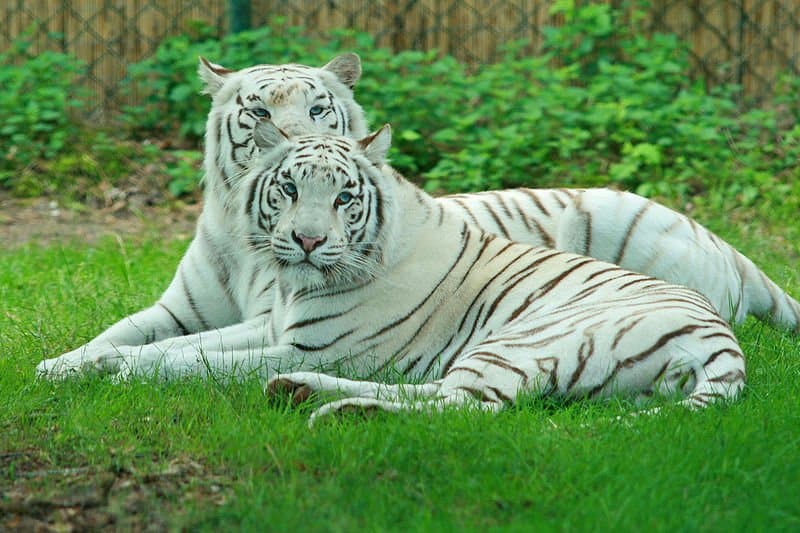
Enemies and competitors
Tiger hunted by wild dogs (
dholes) as illustrated in
Samuel Howett & Edward Orme, Hand Coloured, Aquatint Engravings, 1807
Tigers usually prefer to eat prey they have caught themselves, but
are not above eating carrion in times of scarcity and may even
pirate
prey from other large carnivores. Although predators typically avoid
one another, if a prey item is under dispute or a serious competitor is
encountered, displays of aggression are common. If these are not
sufficient, the conflicts may turn violent; tigers may kill competitors
as
leopards,
dholes,
striped hyenas,
wolves,
bears,
pythons, and
crocodiles on occasion. Tigers may also prey on these competitors.
[42][118][120][121][122][123] Attacks on smaller predators, such as
badgers,
lynxes, and
foxes, are almost certainly predatory.
[93] Crocodiles, bears, and large packs of dholes may win conflicts against tigers and in some cases even kill them.
[42][26][124][125]
The considerably smaller leopard avoids competition from tigers by
hunting at different times of the day and hunting different prey.
[126] In India's
Nagarhole National Park,
most prey selected by leopards were from 30 to 175 kg (66 to 386 lb)
against a preference for prey weighing over 176 kg (388 lb) in the
tigers. The average prey weight in the two respective big cats in India
was 37.6 kg (83 lb) against 91.5 kg (202 lb).
[127]
With relatively abundant prey, tigers and leopards were seen to
successfully coexist without competitive exclusion or interspecies
dominance hierarchies that may be more common to the
African savanna, where the leopard exists with the lion.
[127] Golden jackals may feed on the tiger's kills.
[128]
Reproduction
"Tiger cub" redirects here. For other uses, see
Tiger Cub.
Mating can occur all year round, but is more common between November and April.
[82] A female is only receptive for three to six days.
Mating is frequent and noisy during that time.
Gestation
ranges from 93 to 112 days, with an average of 103 to 105 days. Litters
consist of one or three cubs, rarely also six. Cubs weigh from 680 to
1,400 g (1.50 to 3.09 lb) each at birth, and are born blind. Females
lactate for five to six months.
[57]
The females rears them alone, with the birth site and maternal den in a
sheltered location such as a thicket, cave or rocky crevice. The father
generally takes no part in rearing them. Unrelated wandering male
tigers often kill cubs to make the female receptive, since the tigress
may give birth to another litter within five months if the cubs of the
previous litter are lost. The mortality rate of tiger cubs is about 50%
in the first two years.
[82]
Few other predators attack tiger cubs due to the diligence and ferocity
of the mother. Apart from humans and other tigers, common causes of cub
mortality are starvation, freezing, and accidents.
[116]
A
dominant cub emerges in most litters, usually a male.
[119]
This cub is more active than its siblings and takes the lead in their
play, eventually leaving its mother and becoming independent earlier.
The cubs open their eyes at six to fourteen days old. By eight weeks,
the cubs make short ventures outside the den with their mother, although
they do not travel with her as she roams her territory until they are
older. The cubs are nursed for three to six months. Around the time they
are weaned, they start to accompany their mother on territorial walks
and they are taught how to hunt. The cubs often become capable (and
nearly adult size) hunters at eleven months old. The cubs become
independent around eighteen months of age, but it is not until they are
around two to two and a half years old that they fully separate from
their mother. Females reach sexual maturity at three to four years,
whereas males do so at four to five years. The oldest recorded captive
tiger lived for 26 years. A wild specimen, having no natural predators,
could in theory live to a comparable age.
[82]
Threats
Major threats to the tiger include
habitat destruction,
habitat fragmentation and
poaching for fur and body parts, which have simultaneously greatly reduced tiger populations in the wild
[1] In India, only 11% of the historical tiger habitat remains due to habitat fragmentation.
[129] Demand for tiger parts for use in
traditional Chinese medicine has also been cited as a major threat to tiger populations.
[130][131]
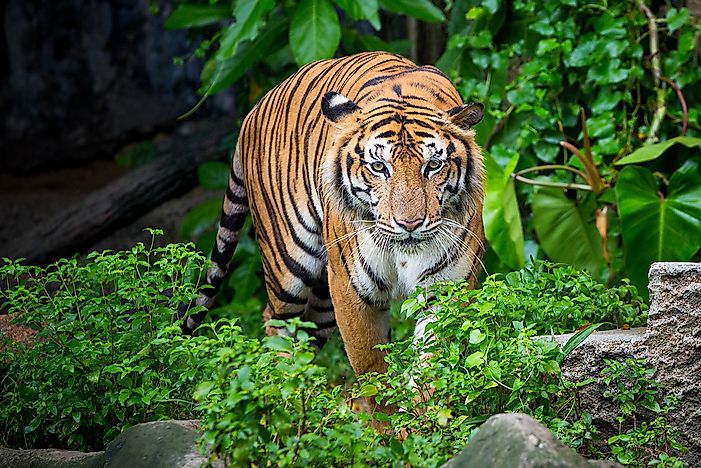
Commercial hunting and traditional medicine
Historically, tigers have been hunted at a large scale so their
famous striped skins could be collected. The trade in tiger skins peaked
in the 1960s, just before international conservation efforts took
effect. By 1977, a tiger skin in an
English market was considered to be worth US$4,250.
[82]
Many people in China and other parts of Asia have a belief that
various tiger parts have medicinal properties, including as pain killers
and
aphrodisiacs.
[132]
There is no scientific evidence to support these beliefs. The use of
tiger parts in pharmaceutical drugs in China is already banned, and the
government has made some offences in connection with tiger poaching
punishable by death.
[which?] Furthermore, all trade in tiger parts is illegal under the
Convention on International Trade in Endangered Species of Wild Fauna and Flora and a domestic trade ban has been in place in China since 1993.
[133]
However, the trading of tiger parts in
Asia has become a major black market industry and governmental and conservation attempts to stop it have been ineffective to date.
[82] Almost all black marketers engaged in the trade are based in
China and have either been shipped and sold within in their own country or into
Taiwan,
South Korea or
Japan.
[82]
The Chinese subspecies was almost completely decimated by killing for
commerce due to both the parts and skin trades in the 1950s through the
1970s.
[82]
Contributing to the illegal trade, there are a number of tiger farms in
the country specialising in breeding the cats for profit. It is
estimated that between 5,000 and 10,000 captive-bred, semi-tame animals
live in these farms today.
[134][135][136] However, many tigers for traditional medicine black market are wild ones shot or snared by
poachers and may be caught anywhere in the tiger's remaining range (from Siberia to India to the
Malay Peninsula to
Sumatra). In the Asian black market, a tiger penis can be worth the equivalent of around $300
U.S. dollars. In the years of 1990 through 1992, 27 million products with tiger derivatives were found.
[82] In July 2014 at an international convention on endangered species in
Geneva,
Switzerland, a Chinese representative admitted for the first time his government was aware trading in tiger skins was occurring in China.
[137]

Conservation
At the start of the 20th century, it was estimated there were over
100,000 tigers in the wild, but the population has dwindled outside of
captivity to between 1,500 and 3,500.
[138][139]
Some estimates suggest that there are fewer than 2,500 mature breeding
individuals, with no subpopulation containing more than 250 mature
breeding individuals.
[1] The global wild tiger population was estimated by the
World Wide Fund for Nature at 3,200 in 2011 and 3,890 in 2015—
Vox reported that this was the first increase in a century.
[140][141]
India is home to the world's largest population of wild tigers.
[4] A 2014 census estimated a population of 2,226, a 30% increase since 2011.
[24] In 1973, India's
Project Tiger, started by
Indira Gandhi,
established over 25 tiger reserves in reclaimed land, where human
development was forbidden. The project was credited with tripling the
number of wild Bengal tigers from some 1,200 in 1973 to over 3,500 in
the 1990s, but a 2007 census showed that numbers had dropped back to
about 1,400 tigers because of poaching.
[142]
Following the report, the Indian government pledged $153 million to the
initiative, set up measures to combat poaching, promised funds to
relocate up to 200,000 villagers in order to reduce human-tiger
interactions,
[143] and set up eight new
tiger reserves.
[144] India also reintroduced tigers to the
Sariska Tiger Reserve[145] and by 2009 it was claimed that poaching had been effectively countered at
Ranthambore National Park.
[146]
In the 1940s, the Siberian tiger was on the brink of extinction with
only about 40 animals remaining in the wild in Russia. As a result,
anti-poaching controls were put in place by the
Soviet Union and a network of protected zones (
zapovedniks)
were instituted, leading to a rise in the population to several
hundred. Poaching again became a problem in the 1990s, when the
economy of Russia collapsed. The major obstacle in preserving the species is the enormous territory individual tigers require (up to 450 km
2 needed by a single female and more for a single male).
[147] Current conservation efforts are led by local governments and
NGO's in concert with international organisations, such as the
World Wide Fund for Nature and the
Wildlife Conservation Society.
[148]
The competitive exclusion of wolves by tigers has been used by Russian
conservationists to convince hunters to tolerate the big cats. Tigers
have less impact on ungulate populations than do wolves, and are
effective in controlling the latter's numbers.
[149] In 2005, there were thought to be about 360 animals in Russia, though these exhibited little
genetic diversity.
[31] However, in a decade later, the Siberian tiger census was estimated from 480 to 540 individuals.
Camera trap image of wild Sumatran tiger
Having earlier rejected the Western-led environmentalist movement,
China changed its stance in the 1980s and became a party to the
CITES treaty. By 1993 it had banned the trade in tiger parts, and this diminished the use of tiger bones in
traditional Chinese medicine.
[150] After this, the
Tibetan people's trade in tiger skins became a relatively more important threat to tigers. The pelts were used in clothing, tiger-skin
chuba being worn by singers and participants in horse racing festivals, and had become
status symbols.
In 2004, international conservation organizations launched successful
environmental propaganda campaigns in China against the Tibetan tiger
skin trade. There was outrage in India, where many Tibetans live, and
the
14th Dalai Lama
was persuaded to take up the issue. Since then there has been a change
of attitude, with some Tibetans publicly burning their chubas.
[151]
In 1994, the Indonesian Sumatran Tiger Conservation Strategy
addressed the potential crisis that tigers faced in Sumatra. The
Sumatran Tiger Project (STP) was initiated in June 1995 in and around
the
Way Kambas National Park
in order to ensure the long-term viability of wild Sumatran tigers and
to accumulate data on tiger life-history characteristics vital for the
management of wild populations.
[152]
By August 1999, the teams of the STP had evaluated 52 sites of
potential tiger habitat in Lampung Province, of which only 15 these were
intact enough to contain tigers.
[153]
In the framework of the STP a community-based conservation programme
was initiated to document the tiger-human dimension in the park in order
to enable conservation authorities to resolve tiger-human conflicts
based on a comprehensive database rather than anecdotes and opinions.
[154]
The
Wildlife Conservation Society and
Panthera Corporation formed the collaboration
Tigers Forever, with field sites including the world's largest tiger reserve, the 21,756 km
2 (8,400 sq mi)
Hukaung Valley in Myanmar. Other reserves were in the
Western Ghats in India, Thailand, Laos, Cambodia, the Russian Far East covering in total about 260,000 km
2 (100,000 sq mi).
[155]
Tigers have been studied in the wild using a variety of techniques.
Tiger population have been estimated using plaster casts of their
pugmarks, although this method was criticized as being inaccurate.
[156] More recent techniques include the use of
camera traps and studies of
DNA from tiger scat, while
radio-collaring has been used to track tigers in the wild.
[157] Tiger spray has been found to be just as good, or better, as a source of DNA than scat.
[158]
The exact number of wild tigers is unknown, as many estimates are
outdated or educated guesses; few estimates are based on reliable
scientific censuses. The table shows estimates according to
IUCN Red List accounts and range country governments dating from 2009 to April 2016.
[4]
Rewilding and reintroduction projects
In 1978, the Indian conservationist
Billy Arjan Singh attempted to
rewild a tiger in
Dudhwa National Park; this was the captive-bred tigress Tara.
[159]
Soon after the release, numerous people were killed and eaten by a
tigress that was subsequently shot. Government officials claimed it was
Tara, though Singh disputed this. Further controversy broke out with the
discovery that Tara was partly Siberian tiger.
[160][161][162][163]
A rewilded South China tiger hunting
blesbok in South Africa
The organisation
Save China's Tigers has attempted to rewild the
South China tigers, with a breeding and training programme in a
South African reserve known as
Laohu Valley Reserve (LVR) and eventually reintroduce them to the wild of China.
[164]
A future rewilding project was proposed for Siberian tigers set to be reintroduced to northern Russia's
Pleistocene park. The Siberian tigers sent to
Iran for a captive breeding project in
Tehran are set to be rewilded and reintroduced to the
Miankaleh peninsula, to replace the now extinct
Caspian tigers.
[165][166][167]

In captivity
In
Ancient Roman
times, tigers were kept in menageries and amphitheatres to be
exhibited, trained and paraded, and were often provoked to fight humans
and exotic beasts.
[168][169]
Since the 17th century, tigers, being rare and ferocious, were sought
after to keep at European castles as symbols of their owners' power.
[170] Tigers became central
zoo and
circus
exhibits in the 18th century: a tiger could cost up to 4,000 francs in
France (for comparison, a professor of the Beaux-Arts at Lyons earned
only 3,000 francs a year),
[171] or up to $3,500 in the United States where a lion cost no more than $1,000.
[172]
China (2007) had over 4,000 captive tigers, of which 3,000 were held
by about twenty larger facilities, with the rest held by some 200
smaller facilities.
[173] The USA (2011) had 2,884 tigers in 468 facilities.
[174] Nineteen states have banned private ownership of tigers, fifteen require a license, and sixteen states have no regulation.
[175] Genetic ancestry
of 105 captive tigers from fourteen countries and regions showed that
forty-nine animals belonged distinctly to five subspecies; fifty-two
animals had mixed subspecies origins.
[176] As such, "many Siberian tigers in zoos today are actually the result of crosses with Bengal tigers."
[177]
The Tiger
Species Survival Plan has condemned the breeding of
white tigers, alleging they are of mixed ancestry and of unknown lineage. The
genes
responsible for white colouration are represented by 0.001% of the
population. The disproportionate growth in numbers of white tigers
points to
inbreeding among
homozygous recessive individuals. This would lead to
inbreeding depression and loss of
genetic variability.
[178]

Relation with humans
Tiger hunting on
elephant-back, India, 1808
Tiger hunting
The tiger has been one of the
big five game animals of
Asia. Tiger hunting took place on a large scale in the early 19th and 20th centuries, being a recognised and admired sport by the
British in
colonial India as well as the
maharajas
and aristocratic class of the erstwhile princely states of
pre-independence India. A single maharaja or English hunter could claim
to kill over a hundred tigers in their hunting career.
[82] Tiger hunting was done by some hunters on foot; others sat up on
machans with a goat or buffalo tied out as bait; yet others on elephant-back.
[179]

Man-eating tigers
Wild tigers that have had no prior contact with humans actively avoid
interactions with humans. However, tigers cause more human deaths
through direct attack than any other wild mammal.
[82]
Attacks are occasionally provoked, as tigers lash out after being
injured while they themselves are hunted. Attacks can be provoked
accidentally, as when a human surprises a tiger or inadvertently comes
between a mother and her young,
[180] or as in a case in rural India when a postman startled a tiger, used to seeing him on foot, by riding a bicycle.
[181]
Occasionally tigers come to view people as prey. Such attacks are most
common in areas where population growth, logging, and farming have put
pressure on tiger habitats and reduced their wild prey. Most man-eating
tigers are old, missing teeth, and unable to capture their preferred
prey.
[58] For example, the
Champawat Tiger, a tigress found in
Nepal and then
India,
had two broken canines. She was responsible for an estimated 430 human
deaths, the most attacks known to be perpetrated by a single wild
animal, by the time she was shot in 1907 by
Jim Corbett.
[65]
According to Corbett, tiger attacks on humans are normally in daytime,
when people are working outdoors and are not keeping watch.
[182] Early writings tend to describe man-eating tigers as cowardly because of their ambush tactics.
[183]
Man-eaters have been a particular problem in recent decades in India and Bangladesh, especially in
Kumaon,
Garhwal and the
Sundarbans mangrove swamps of
Bengal, where some healthy tigers have hunted humans. Because of rapid habitat loss attributed to
climate change, tiger attacks have increased in the Sundarbans.
[185]
The Sundarbans area had 129 human deaths from tigers from 1969 to 1971.
In the 10 years prior to that period, about 100 attacks per year in the
Sundarbans, with a high of around 430 in some years of the 1960s.
[82] Unusually, in some years in the Sundarbans, more humans are killed by tigers than vice versa.
[82] In 1972, India's production of
honey and beeswax dropped by 50% when at least 29 people who gathered these materials were devoured.
[82]
In 1986 in the Sundarbans, since tigers almost always attack from the
rear, masks with human faces were worn on the back of the head, on the
theory that tigers usually do not attack if seen by their prey. This
decreased the number of attacks only temporarily. All other means to
prevent attacks, such as providing more prey or using electrified human
dummies, worked less well.
[186]
At least 27 people were killed or seriously injured by captive tigers in the United States from 1998 to 2001.
[187][187]
In some cases, rather than being predatory, tiger attacks on human
seem to be territorial in nature. At least in one case, a tigress with
cubs killed eight people entering her territory without consuming them
at all.
[188]

Cultural depictions

Tigers and their superlative qualities have been a source of
fascination for mankind since ancient times, and they are routinely
visible as important cultural and media motifs. They are also considered
one of the
charismatic megafauna, and are used as the face of conservation campaigns worldwide. In a 2004 online poll conducted by cable television channel
Animal Planet,
involving more than 50,000 viewers from 73 countries, the tiger was
voted the world's favourite animal with 21% of the vote, narrowly
beating the dog.
[189]
In myth and legend
The Hindu goddess
Durga riding a tiger. Guler school, early 18th century
In
Chinese myth and
culture, the
tiger is one of the 12 animals of the
Chinese zodiac. In
Chinese art, the tiger is depicted as an earth symbol and equal rival of the
Chinese dragon – the two representing matter and spirit respectively. The Southern Chinese martial art
Hung Ga is based on the movements of the tiger and the crane. In
Imperial China, a tiger was the personification of war and often represented the highest army
general (or present day
defense secretary),
[190] while the emperor and empress were represented by a
dragon and
phoenix, respectively. The
White Tiger (
Chinese:
白虎;
pinyin:
Bái Hǔ) is one of the
Four Symbols of the
Chinese constellations. It is sometimes called the White Tiger of the West (西方白虎), and it represents the
west and the autumn season.
[190]
The
tiger's tail appears in stories from countries including China and Korea, it being generally inadvisable to grasp a tiger by the tail.
[191][192]
In
Buddhism,
the tiger is one of the Three Senseless Creatures, symbolising anger,
with the monkey representing greed and the deer lovesickness.
[190] The
Tungusic peoples considered the Siberian tiger a near-deity and often referred to it as "Grandfather" or "Old man". The
Udege and
Nanai called it "Amba". The
Manchu considered the Siberian tiger as "Hu Lin," the king.
[63] In
Hinduism, the god
Shiva wears and sits on tiger skin.
[193] The ten-armed warrior goddess
Durga rides the tigress (or lioness) Damon into battle. In southern India the god
Ayyappan was associated with a tiger.
[194]
The
weretiger replaces the
werewolf in
shapeshifting folklore in Asia;
[195] in India they were evil sorcerers, while in Indonesia and Malaysia they were somewhat more benign.
[196] In the Hindu epic
Mahabharata, tigers are fiercer and more ruthless than lions.
[197]
In literature, art and film
In
William Blake's poem in the
Songs of Experience, titled "
The Tyger," the tiger is a menacing and fearful animal. In
Yann Martel's 2001
Man Booker Prize winning novel
Life of Pi,
the protagonist, surviving shipwreck for months in a small boat,
somehow avoids being eaten by the other survivor, a large Bengal tiger.
The story was adapted in
Ang Lee's 2012
feature film of the same name.
Jim Corbett's 1944
Man-Eaters of Kumaon tells ten true stories of his tiger-hunting exploits in what is now the northern
Uttarakhand region of India. The book has sold over four million copies,
[198] and has been the basis of both fictional and documentary films. In
Rudyard Kipling's 1894
The Jungle Book, the tiger,
Shere Khan, is the mortal enemy of the human protagonist,
Mowgli;
the book has formed the basis of both live-action and animated films.
Other tiger characters aimed at children tend to be more benign, as for
instance
Tigger in
A. A. Milne's
Winnie-the-Pooh and
Hobbes of the comic strip
Calvin and Hobbes, both of whom are represented as simply stuffed animals come to life.
Tiger are also mascots for various
sports teams around the world.
Tony the Tiger is a famous mascot for
Kellogg's breakfast cereal Frosted Flakes. The
Esso (Exxon)
brand of petrol was advertised from 1969 onwards with the slogan 'put a
tiger in your tank', and a tiger mascot; more than 2.5 million
synthetic tiger tails were sold to motorists, who tied them to their
petrol tank caps.
[199]
The tiger appears in
heraldry but is distinct from the heraldic beast
tyger, a wolflike, snouted creature which has its roots in European Medieval
bestiaries.
Political symbolism
The tiger is one of the animals displayed on the
Pashupati seal of the
Indus Valley Civilisation. The tiger was the emblem of the
Chola Dynasty and was depicted on coins, seals and banners.
[200] The seals of several Chola copper coins show the tiger, the
Pandyan emblem fish and the
Chera
emblem bow, indicating that the Cholas had achieved political supremacy
over the latter two dynasties. Gold coins found in Kavilayadavalli in
the
Nellore district of
Andhra Pradesh have motifs of the tiger, bow and some indistinct marks.
[201] The tiger symbol of Chola Empire was later adopted by the
Liberation Tigers of Tamil Eelam and the tiger became a symbol of the unrecognised state of
Tamil Eelam and Tamil independence movement.
[202]
The Bengal tiger is the
national animal of India and Bangladesh.
[203] The Malaysian tiger is the national animal of
Malaysia.
[204] The Siberian tiger is the national animal of
South Korea. Since the successful economies of
South Korea,
Taiwan,
Hong Kong and
Singapore were described as the
Four Asian Tigers, a
tiger economy is a metaphor for a nation in rapid development.





















































